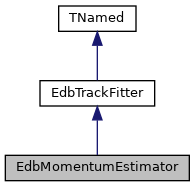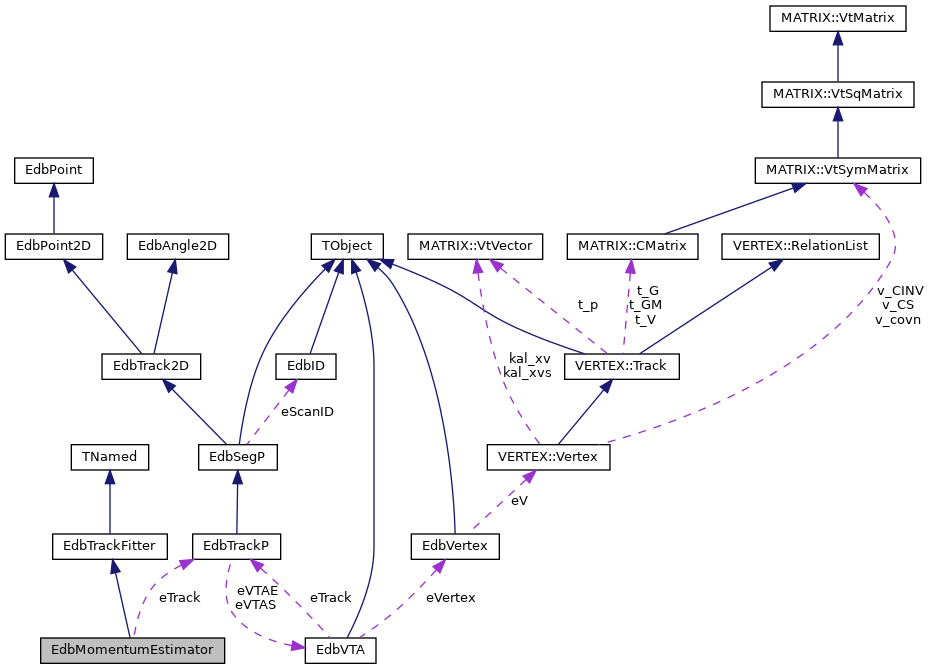Version rewised by VT 13/05/2008 (see PMSang_base) and further modified by Magali at the end of 2008
calculate momentum in transverse and in longitudinal projections using the different measurements errors parametrisation
256{
265
268 if(nseg<2) {
Log(1,
"PMSang",
"Warning! nseg<2 (%d)- impossible estimate momentum!",nseg);
return -99;}
269 if(npl<nseg) {
Log(1,
"PMSang",
"Warning! npl<nseg (%d, %d) - use track.SetCounters() first",npl,nseg);
return -99;}
270 int plmax = Max(
tr.GetSegmentFirst()->PID(),
tr.GetSegmentLast()->PID() ) + 1;
271 if(plmax<1||plmax>1000) {
Log(1,
"PMSang",
"Warning! plmax = %d - correct the segments PID's!",plmax);
return -99;}
272
273
274 float xmean,ymean,zmean,txmean,tymean,wmean;
275 float xmean0,ymean0,zmean0,txmean0,tymean0,wmean0;
277 float tmean=Sqrt(txmean0*txmean0+ tymean0*tymean0);
278
280 float sigmax=0, sigmay=0;
281 for (
int i =0;i<
tr.N();i++)
282 {
283 aas=
tr.GetSegment(i);
284 sigmax+=(txmean0-aas->
TX())*(txmean0-aas->
TX());
285 sigmay+=(tymean0-aas->
TY())*(tymean0-aas->
TY());
286 }
287 sigmax= Sqrt(sigmax/
tr.N());
288 sigmay= Sqrt(sigmay/
tr.N());
289 for (
int i =0;i<
tr.N();i++)
290 {
291 aas=
tr.GetSegment(i);
292 if(Abs(aas->
TX()-txmean0)>3*sigmax||Abs(aas->
TY()-tymean0)>3*sigmay) {
293 aas->
Set(aas->
ID(),aas->
X(),aas->
Y(),0.,0.,aas->
W(),aas->
Flag());}
294 }
295
297
298
299
300
301
302
303 float PHI=atan2(txmean0,tymean0);
304 for (
int i =0;i<
tr.N();i++)
305 {
306 aas=
tr.GetSegment(i);
307 float slx=aas->
TY()*cos(-PHI)-aas->
TX()*sin(-PHI);
308 float sly=aas->
TX()*cos(-PHI)+ aas->
TY()*sin(-PHI);
309 aas->
Set(aas->
ID(),aas->
X(),aas->
Y(),slx,sly,aas->
W(),aas->
Flag());
310 }
311
313
314
315
316
317
318
320 int stepmax = npl-1;
321 const int size = stepmax+1;
322
323 TVectorF da(size), dax(size), day(size);
324 TArrayI nentr(size), nentrx(size), nentry(size);
325
327 for(int ist=1; ist<=stepmax; ist++)
328 {
329 for(int i1=0; i1<nseg-1; i1++)
330 {
331 s1 =
tr.GetSegment(i1);
333 for(int i2=i1+1; i2<nseg; i2++)
334 {
335 s2 =
tr.GetSegment(i2);
338 if( icell == ist )
339 {
341 {
342 dax[icell-1] += ( (ATan(
s2->
TX())- ATan(
s1->
TX())) * (ATan(
s2->
TX())- ATan(
s1->
TX())) );
343 nentrx[icell-1]+=1;
344 }
346 {
347 day[icell-1] += ( (ATan(
s2->
TY())- ATan(
s1->
TY())) * (ATan(
s2->
TY())- ATan(
s1->
TY())) );
348 nentry[icell-1]+=1;
349 }
351 {
352 da[icell-1] += (( (ATan(
s2->
TX())- ATan(
s1->
TX())) * (ATan(
s2->
TX())- ATan(
s1->
TX())) )
354 nentr[icell-1] +=1;
355 }
356 }
357 }
358 }
359 }
360
361 float Zcorr = Sqrt(1+txmean0*txmean0+tymean0*tymean0);
362
363 int maxX =0, maxY=0, max3D=0;
364 TVectorF vindx(size), errvindx(size),vindy(size), errvindy(size),vind3d(size), errvind3d(size);
365 TVectorF errda(size), errdax(size), errday(size);
366 int ist=0, ist1=0, ist2=0;
367 for(int i=0; i<size; i++)
368 {
369 if( nentrx[i] >= minentr && Abs(dax[i])<0.1)
370 {
371 vindx[ist] = i+1;
372 errvindx[ist] = .25;
373 dax[ist] = Sqrt( dax[i]/(nentrx[i]*Zcorr) );
374 errdax[ist] = dax[ist]/Sqrt(2*nentrx[i]);
375 ist++;
376 maxX=i+1;
377 }
378 if( nentry[i] >= minentr && Abs(day[i])<0.1)
379 {
380 vindy[ist1] = i+1;
381 errvindy[ist1] = .25;
382 day[ist1] = Sqrt( day[i]/(nentry[i]*Zcorr) );
383 errday[ist1] = day[ist1]/Sqrt(2*nentry[i]);
384 ist1++;
385 maxY=i+1;
386 }
387 if( nentr[i] >= minentr/2 && Abs(da[i])<0.1 )
388 {
389 vind3d[ist2] = i+1;
390 errvind3d[ist2] = .25;
391 da[ist2] = Sqrt( da[i]/(2*nentr[i]*Zcorr) );
392 errda[ist2] = da[ist2]/Sqrt(4*nentr[i]);
393 ist2++;
394 max3D=i+1;
395 }
396 }
397
399 dt*=dt;
400 float dtx =
GetDTx(txmean);
401 dtx*=dtx;
402 float dty =
GetDTy(tymean);
403 dty*=dty;
404
406 float chi2_3D =0;
407 float chi2_T =0;
408 float chi2_L =0;
409
416
418 eF1X->SetParameter(0,2000.);
420 eF1Y->SetParameter(0,2000.);
422 eF1->SetParameter(0,2000.);
423
424 if (max3D>0)
425 {
426 eG=
new TGraphErrors(vind3d,da,errvind3d,errda);
428 eP=1./1000.*Abs(
eF1->GetParameter(0));
429 eDP=1./1000.*
eF1->GetParError(0);
432 chi2_3D =
eF1->GetChisquare()/
eF1->GetNDF();
433 if (
eVerbose) printf(
"P3D=%7.2f GeV ; 90%%C.L. range = [%6.2f : %6.2f] ; chi2_3D %6.2f\n",
eP,
ePmin,
ePmax,chi2_3D);
434 }
435 if (maxX>0)
436 {
437 eGX=
new TGraphErrors(vindx,dax,errvindx,errdax);
438 eGX->Fit(
"eF1X",
"QR");
439 ePx=1./1000.*Abs(
eF1X->GetParameter(0));
443 chi2_L =
eF1X->GetChisquare()/
eF1X->GetNDF();
444 if (
eVerbose) printf(
"PL=%7.2f GeV ; 90%%C.L. range = [%6.2f : %6.2f] ; chi2_L %6.2f \n",
ePx,
ePXmin,
ePXmax,chi2_L);
445 }
446 if (maxY>0)
447 {
448 eGY=
new TGraphErrors(vindy,day,errvindy,errday);
449 eGY->Fit(
"eF1Y",
"QR");
450 ePy=1./1000.*Abs(
eF1Y->GetParameter(0));
454 chi2_T =
eF1Y->GetChisquare()/
eF1Y->GetNDF();
455 if (
eVerbose) printf(
"PT=%7.2f GeV ; 90%%C.L. range = [%6.2f : %6.2f] ; chi2_T %6.2f\n",
ePy,
ePYmin,
ePYmax,chi2_T);
456 }
457
459 if (tmean>0.200&&chi2_T<chi2_3D)
460 {
462 if (
eVerbose) printf(
" For this track the evolution of the Transverse projection gives the most accurate estimate of the momentum %7.2f GeV ; 90%%C.L. range = [%6.2f : %6.2f] ; chi2_T /DoF %6.2f\n",
ePy,
ePYmin,
ePYmax,chi2_T);
463}
464
465
466
467
468
469
470
471 return ptrue;
472}
double GetDTx(double Tx)
Definition: EdbMomentumEstimator.h:81
TF1 * MCSErrorFunction(const char *name, float x0, float dtx)
Definition: EdbMomentumEstimator.cxx:658
float eDPy
the fit error
Definition: EdbMomentumEstimator.h:37
float ePx
the fit results
Definition: EdbMomentumEstimator.h:36
double GetDTy(double Ty)
Definition: EdbMomentumEstimator.h:82
float ePy
the estimated momentum
Definition: EdbMomentumEstimator.h:36
float eDPx
Definition: EdbMomentumEstimator.h:37
void EstimateMomentumError(float P, int npl, float ang, float &pmin, float &pmax)
Definition: EdbMomentumEstimator.cxx:699
float eDP
Definition: EdbMomentumEstimator.h:43
double GetDTs(double Ts)
Definition: EdbMomentumEstimator.h:83
Int_t ID() const
Definition: EdbSegP.h:147
Float_t W() const
Definition: EdbSegP.h:151
Int_t Flag() const
Definition: EdbSegP.h:149
void Set(int id, float x, float y, float tx, float ty, float w, int flag)
Definition: EdbSegP.h:87
int FitTrackLine(EdbTrackP &tr)
Definition: EdbTrackFitter.cxx:520


 Public Member Functions inherited from EdbTrackFitter
Public Member Functions inherited from EdbTrackFitter Public Attributes inherited from EdbTrackFitter
Public Attributes inherited from EdbTrackFitter Static Public Member Functions inherited from EdbTrackFitter
Static Public Member Functions inherited from EdbTrackFitter